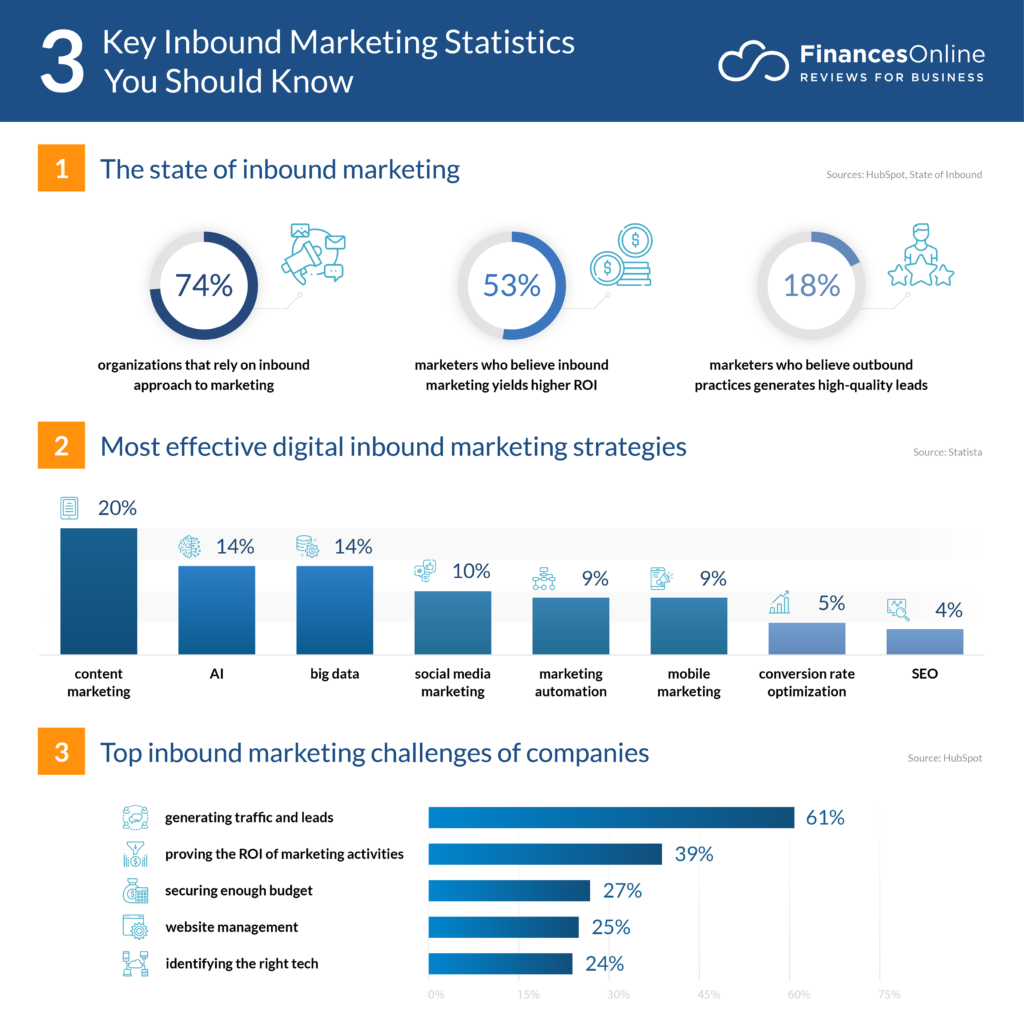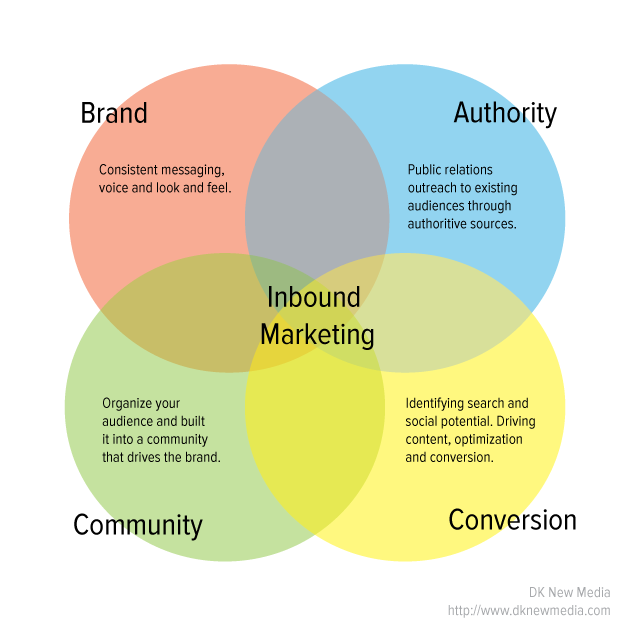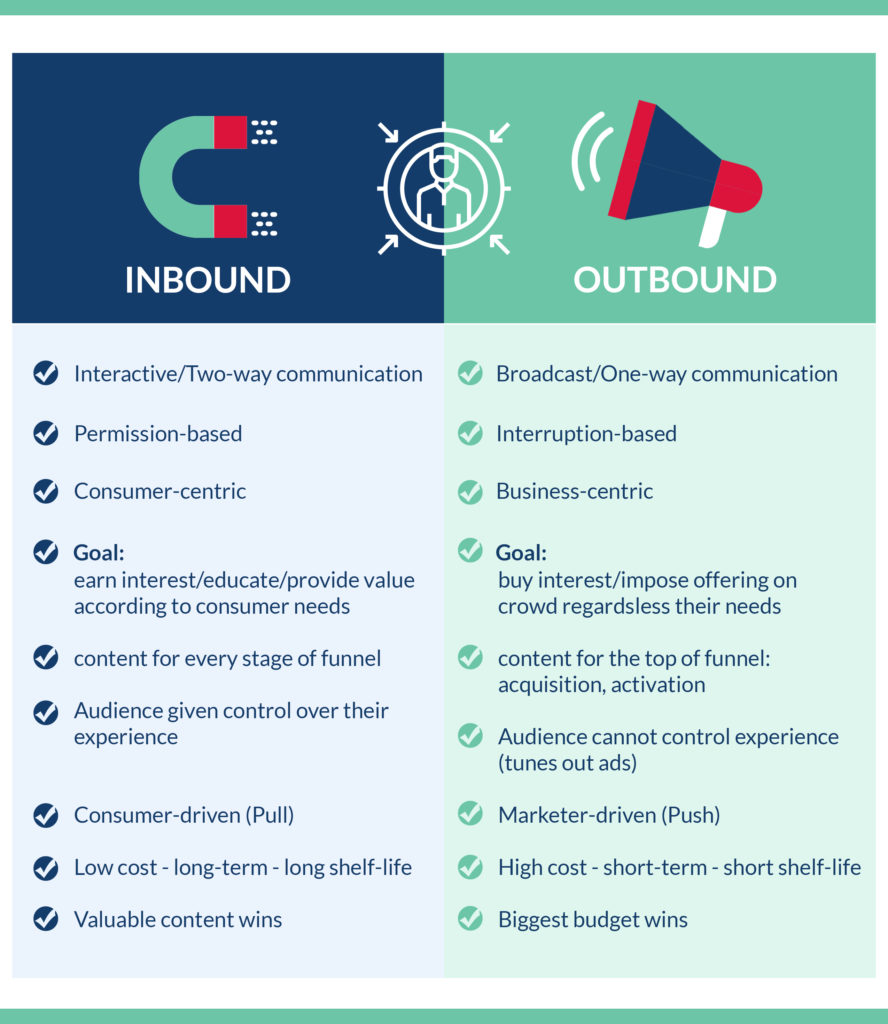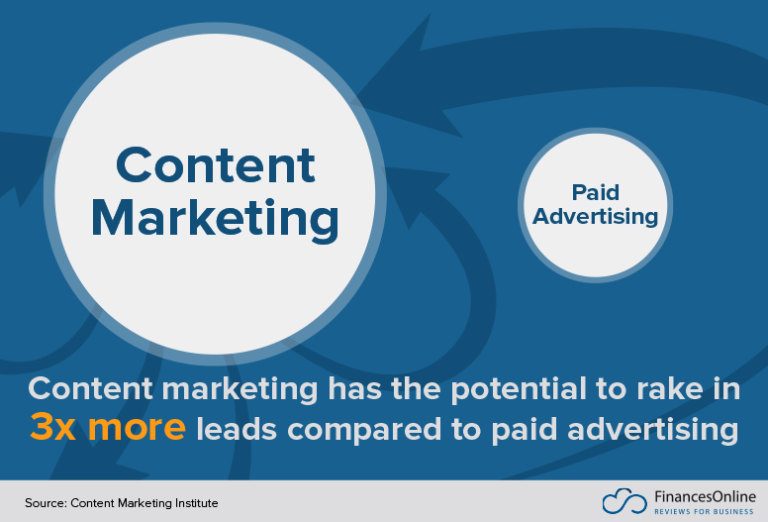Table of Contents:
- What is Inbound Marketing?
- Benefits of Inbound marketing
- Inbound Vs Outbound marketing
- Types of Inbound Marketing
- Buyer Personas
- Website Design
- Content Marketing – Blogs
- Search Engine Optimization
- Lead Generation
- Social Media
- Lifecycle Marketing
- Personalization
- Marketing Automation
- Video Inbound marketing
- Methods of Inbound Marketing
- Attract
- Engage
- Convert
- Close
- Delight
- Best Inbound Marketing Software & Tools
- HubSpot
- Salesforce Pardot
- AdRoll
- Hotjar
- Marketo
- Steps for a Successful Inbound Marketing Strategy
- Conclusion
What is Inbound Marketing?
Inbound marketing is a strategy for growing your business and creating long-term customer relationships by engaging customers, prospects, and clients and pulling them to your brand website via SEO, content marketing, social media, video marketing, and more. The aim of a successful inbound marketing campaign is to increase reach and drive quality traffic to your website, customer engagement and higher conversions.

Did you know?
- 74% of all organizations rely on the Inbound approach to marketing
- 61% of leads are generated from the inbound marketing approach
- Inbound Marketing generates 54% more leads than the traditional marketing approach
- Inbound marketing costs 62% less per lead than traditional outbound marketing
- Companies that blog typically receive 97% more inbound links
Developing a successful inbound marketing plan will help in increasing your customer base and conversions. With 20+ years of experience, PROS marketing experts deliver data-driven results through content marketing, SEO, social media, and more.
Let’s take a look at what an Inbound Marketing process entails for inbound marketers and how can an e-commerce business benefit from it in terms of ROI and brand exposure.

There are many benefits of Inbound marketing. Following are the top key benefits of the same:
Reach out to the target audience
The marketing approach targets Buyers’ Persona. Inbound marketing empathizes with an e-commerce business target audience. The approach provides great content and unlimited support to its customers. Inbound marketers channel their resources towards the specified areas which bring maximized results to the business. Positive communication lays the foundation for stronger customer relationships.
Generates More Leads and Conversions
Lead creation is one of the key aims of inbound marketing. An e-commerce business should provide viewers with a positive user experience. In exchange for their contact information, inbound marketers actively supply new leads with efficient resources. Look for opportunities to convert them into permanent loyal customers through webinars, client testimonials, or whitepapers.
Creates Brand Awareness
An effective marketing process of Inbound marketing includes awareness of e-commerce brands amongst the users. Showing visitors the brand value makes them more attracted to the brand. As a result, visitors who interact with your material will gradually learn more about your brand and market position.
Increases ROI
The inbound marketing approach is more beneficial than our traditional marketing. Inbound marketing includes increasing the sales of an e-business organization by understanding clients and speaking to them directly about requirements, issues, and preferences. It engages customers and overall adds to an increased ROI for businesses.

Inbound and outbound difference
Based on Goal
Inbound Marketing
The primary goal is to attract the target audience of an e-commerce website by providing both meaningful and personalized marketing experiences.
Outbound Marketing
The main goal is to approach a broad set of audiences to present them with an e-commerce product or service.
The Method
Inbound Marketing
Methods of Inbound marketing include effective blog posts, videos, ideas for infographics, email newsletters, e-books, etc.
Outbound Marketing
Methods of marketing are cold calls, emails, broadcast media, and more.
Messaging
Inbound Marketing
Messages are customer-driven. Which aim to provide value to consumers’ preferences and customers in need of certain services.
Outbound Marketing
Messages are marketer-driven. Which intends to buy value from consumers, neglecting all their needs.
Buyer Persona
The buyer is the king of an e-commerce business. When it comes to purchasing and selling, the power of the seller is shifted to the buyer. A buyer persona is a made-up, generalized image of a company’s ideal clients. Personas make it simpler to understand the market research and insights from your existing client base.
The following is what a buyer persona reveals:
- The circumstances that lead a buyer’s choice to look for a solution.
- The buyer’s expected outcomes or effects from the solution
- The attitude of buyers keeps them from buying the solution
- The buyer’s role in deciding who else will impact their decision
- All features that buyers evaluate while comparing alternatives.
5 essential key elements of buying Insights:
Priority initiatives
This describes why some buyers make the solution category a strategic priority. On the other hand, some of them chose the status quo, for the same.
Success factors
It reveals the expectations of buyers after implementing your e-commerce solution.
Perceived barriers
This describes why some viewers wouldn’t convert and perceive your company as their priority option.
The buyer’s journey
Describes all those buyers who are involved in the decision and resources that lead to deciding their opinions.
Decision criteria
Reveals all the criteria by the buyers to evaluate solution options. Also, the purchasing decision and the reason behind why.
Demographics, needs, challenges, common and specific objectives, communication channels, etc are important to capture buyers’ persona. Once you know the buyer persona, it is time to invest your time in website designing.
Website Design
Many e-businesses struggle with the traditional process of marketing and sales campaigns. The real struggle with the traditional approach was a significant investment, front costs, delay in the project, and over budgeting. However, with new technology, the process of Growth-Driven Design helped inbound marketers in driving continuous improvement throughout the time.
A brief about GDD
Growth-Driven Design is a continuous process that focuses on producing monthly reliable growth. An e-commerce website becomes stronger month-over-month, as inbound marketers measure, iterate, and act. By decreasing your initial upfront commitment of time, money, and resources, you may avoid the difficulties of traditional web design.
Benefits of GDD
- GDD allows inbound marketers to create consistent month-over-month growth.
- GDD reduces the overall risk in the website development process.
- As a business continues to measure, iterate, and act, its website will grow stronger and sales-generating.
An e-commerce website’s development is never complete. The GDD Methodology is meant to adapt and alter to fit the purchasing habits of your target consumers. Users’ information is utilized to develop an e-commerce website and to keep up with marketing and sales.
Content Marketing

Inbound Marketing includes content marketing. The quality of content is the main focus of Inbound Marketing. Content marketing is a strategic marketing approach that focuses on creating valuable, relevant, and consistent content and distributing the same to attract viewers to an e-commerce website. Which drives inbound results, which converts visitors into leads and sales of the e-business.
Importance of blog in Inbound Marketing
Inbound marketing relies on content to succeed. Both of them are intertwined as components. Content material like blogs, eBooks, and more is always in the spotlight. A blog may be found on practically every e-business website. Blogging is an efficient approach to attracting visitors to your e-commerce website.
Importance of blog marketing:
- Blogs drive relevant traffic
- They convert visitors into leads
- Blogs aware readers on an e-commerce website
- They help solve the problems of the readers
- They provide long-term opportunities for a business to grow
With the help of automatic nurturing emails and lead intelligence, leads in your website turn into customers. Content marketing and SEO drive visitors to your e-commerce website. Further, we will discuss SEO as an important part of Inbound marketing.
Search Engine Optimization
Search is the first step in a buyer’s journey. Creating awareness about challenges, testimonials, reviews, costs, and cases is important for an e-commerce website. SEO requires both technical and design elements to rank your e-commerce website higher. Creating relevant content that fascinates consumers is essential for increasing SEO and attracting viewers.
SEO use the following to generate sales and income:
- Site pages
- Blogs
- In-Depth guides
- Infographics
- Videos
SEO increases the visibility of e-commerce businesses in relevant internet search results. If an e-commerce website is not effectively optimized, a merchant may find it difficult to generate visitors to their website. Once your website is ranked high in SEO, increasing website traffic into generating revenues is an important aspect. Below we will discuss Lead Generation.
Lead Generation
Inbound marketing includes the process of lead generation. It turns website traffic into revenues by creating content and prospects for your organization.
After performing different steps like buyer personas, you will have an understanding of the type of content to create for your e-commerce websites. Valuable unique content can be created using the STEPPS framework, by Dr. Jonah Berger.
The STEPS framework
1. Social Currency
People want to seem smart, and cool. They care about the way they look. Therefore, your e-commerce website should make people feel like insiders.
2. Triggers
Make your context unique, and attractive. It should trigger your viewers. So that audiences are constantly thinking about your products or idea frequently.
3. Emotion
Brands that show that they care while sharing their products occupy a good position in the market. The emotional content of websites often goes viral. Therefore, focusing on feelings rather than function may make your website stand out.
4. Public
Design to expand your e-business. Make it well-known so that more people are likely to imitate it. Create items and efforts that are self-promotional.
5. Practical Value
Be practical. A merchant may use relatable news. Facts and other useful things get shared easily. Therefore, highlighting incredible content that people can share adds value to the e-business.
6. Stories
Creating a compelling story that carries your concept is important. Narratives are trending over the internet. Keep your narratives interesting so that people want to carry the same idea along.
The STEPPS framework is important. It is applied to almost all phases of inbound marketing. And is very critical in the conversation phase.
Why does it matter?
The material of the e-commerce business has to be better than it has ever been. To generate revenue you must give genuine value that fits the needs of your customers.
Your e-commerce website content needs to be impressive. It should add meaning to viewers to your e-commerce website.
Once people start liking your content, they will be likely to join your business community by subscribing to your email updates.
Subscribers or leads
Do not focus on leads. Focus on increasing subscribers base. Subscribers are not your e-commerce leads. But, they are more essential than leads. They stay up-to-date with your website content and consume and share it with others. Therefore inbound marketers must provide sufficient opportunities to their subscribers.
A merchant can successfully increase the subscriber base through social media.
Social media
Social media has grown as a communicative channel for all age groups. Billions of people use Facebook and Instagram. Therefore, Facebook and Instagram marketing should be a part of social strategy. Alongside, people are actively using Linkedin, Snapchat, Twitter, and Youtube.
Importance of Social media
- Social media lets a merchant focus on having real conversations with their real audience. It helps a business to be relevant, helpful, and friendly
- Attracting and engaging your e-commerce targeted audience should be the initial step. Further, lead conversion should be a critical step to your e-business success
- People can enjoy the app and generate awareness of your e-commerce products and services
- The reach of social media networking is huge. A merchant can attract a lot of buyers.
Inbound marketing includes social media. They add value to the process. The platforms create awareness amongst people. This further helps in creating a long healthy relationship between buyers with customers. Below, we will know the secret of lifecycle marketing.
Lifecycle marketing
Lifecycle marketing is the mix of strategies a company uses to positively influence customer behavior as they move through each touchpoint of the marketing cycle, from the initial attraction to becoming a brand loyalist.
No matter the cycle length, there are various stages that make up any lifecycle marketing plan. Understanding these will help you target your audience’s specific needs at each stage, whether they’re coming in as a lead, first-time buyer, repeat customer, or lapsed customer. Take a look at the main lifecycle stages below:
- Awareness
- Engagement
- Evaluation
- Purchase
- Support
- Loyalty
Strategy is the key to successful lifecycle marketing. Without it, you will likely bring in the wrong leads and waste your marketing budget on people who won’t turn into brand loyalists. With lifecycle marketing, you can:
- Grow your customer base by offering a better buying experience
- Improve sales by turning one-time buyers into repeat customers
- Turn buyers into brand advocates who rave about your company
- Improve your marketing ROI and lifetime customer value
Personalization
Inbound Marketing includes taking advantage of accessible data. So that it can provide a more tailored experience to the viewers. The information gathered is a result of visitors’ interactions with your website. Personalize calls-to-action marketing and web page content.
Importance of Personalisation in Inbound marketing
- It improves the experience of visitors
- It does not end with closing sales
- Engages viewers in all phases of the buying journey
- People trust word of mouth. Which triggers the sales
- Turns viewers into loyal customers
Personalization Inbound marketing provides the right content to the right person at the right time. Personalizing material depends on how users interact with it, and their interests and requirements. For this, a merchant can use marketing automation to provide a personalized customer experience.
Marketing Automation
It’s difficult for a sales team to pursue every single prospect, and it’s also impractical for a merchant to nurture every connection manually as a marketer. If a business doesn’t have an active lead management and prospect nurturing system, it will soon waste your marketing investment. Therefore, marketing automation for inbound marketers is a great solution.
What is Marketing Automation?
Marketing automation uses software that automates repetitive marketing tasks. Marketing departments can automate repetitive processes like email marketing, social media posting, and even ad campaigns, not just for efficiency but also to give their customers a more personalized experience. A few marketing automation software are:
- Klaviyo
- Omnisend
- Sendlane
Benefits of Marketing Automation
Efficiency: marketing automation makes your entire department more efficient. You can potentially reduce staffing costs while freeing up your team’s time to work on more important, strategic projects.
Marketing and sales alignment: When you combine your sales and marketing automation efforts by using the same software, you’ll be able to align company goals and efforts.
Increase conversion rate: Marketing automation software can help you increase your conversion rate and manage your leads more efficiently.
Accurate reporting: Reporting your analytics can seem like a daunting process, but with marketing automation platforms. You should be able to use your software to generate automated reports.
Personalized marketing strategy: As your team spends more time creating instead of doing manual data entry, marketing automation software will allow them to create more personalized content through its segmentation capabilities and reporting.
Lead scoring: Marketing automation software can set up lead scoring for your team which will notify your sales team when a lead goes from a marketing qualified lead to a sales qualified lead.
Data management: marketing automation platforms will keep track of your leads and their engagement with your site. It keeps your data up to date automatically.
Scalable processes: Marketing automation will help you create processes that are scalable.
Lead nurturing: marketing automation makes lead nurturing possible. Marketing automation software is the place you’ll create drip email campaigns and track their success
Marketing Automation helps e-businesses to successfully run marketing campaigns. Further, is a description of an emerging video Inbound Marketing.
Video Inbound Marketing
Video inbound marketing is similar to blogs and other content downloads. As it gives plenty of value to the viewers. Video inbound marketing includes replacing writing plans with a storyboard and content with visuals and audio. A video inbound marketing topic should be relevant and focused.
Benefits of Video Inbound Marketing
- More customers watch videos than reading blog articles
- A merchant can use content strategy alongside
- Videos are easily found through Google
- Videos share an inside view of your e-business
- Videos can easily persuade people to buy your products, ideas, and services
- Videos can be more engaging via live videos
- Videos give you a competitive advantage over competitors
- Videos build the trust of people
- Solve consumer challenges in a few minutes
Videos make buying decisions for most of the customers. Inbound videos help accelerate that process by the following five methods.
Methods of Inbound Marketing
The methods of Inbound marketing are divided into three subparts:- Before viewers are aware of your e-business
- During this time, viewers learn about your e-business
- Afterward, viewers become your e-business customers
- It is essential to attract viewers when they are strangers. Attracting viewers is the first step to creating awareness.
- Once a viewer is attracted by your product or idea. Make sure you keep him engaged in your website with efficient content, graphics, etc.
- Once the viewer starts trusting you. It is time to convert them into your regular loyal customers.
Best Inbound Marketing Software & Tools
There is much effective software that helps in building the Inbound Marketing process. Following is the list of a few of themHubSpot
HubSpot is a cloud-based CRM designed to help align sales and marketing teams, foster sales enablement, boost ROI and optimize your inbound marketing strategy to generate more, qualified leads.Salesforce Pardot
Pardot is a B2B marketing automation and lead generation tool from Salesforce. Pardot can be used to route leads to sales, create and track automated marketing campaigns, analyze prospect activity and engagement, and guide prospects through the buying journey.AdRoll
The e-commerce marketing software, AdRoll provides growing D2C brands the power to connect to their customers. The software provides predicted behavior, store performance, ad engagement, and other effective features to an e-commerce merchant.Hotjar
Hotjar is a powerful tool that reveals the online behavior and voice of your users. By combining both Analysis and Feedback tools, Hotjar gives you a 360 view of how to improve your site’s user experience and performance/conversion rates.Marketo
The software specializes in providing solutions for large e-commerce enterprises. Marketo software was built for advanced inbound marketers. It offers features like integrated blogging, website hosting, SEO, lead capture, conversion, etc. Marketo software requires efficient IT knowledge to operate. Therefore, without a specialist, it can be highly time-consuming.Steps for a Successful Inbound Marketing Strategy
Step 1: Setting Goals
The first step in creating an inbound marketing strategy is to define your e-commerce business goals. A merchant has to look at their competitors, industry market, and where they are in that market to create realistic and attainable goals. Once you have created a buyer persona. Carry out industry research with your competitor.Step 2: Getting Found
Once you have an understanding of your targeted audience, it is important to find out how people are searching for your content.Keyword Research
Keyword research allows you to see an estimated global and local search volume to your website, and ranking difficulty. This research also predicts the cost of running paid campaigns. Keyword research also helps you to target the right visitors to your website.Onsite SEO
This refers to all of the elements on a website page that have an impact on search engine rankings. The suitable keyword should be included in the text, and image tags on all the pages. It is essential to perform onsite SEO for every existing and future page that you create for your website.Editorial Calendar
Before starting with your blogging campaign, come up with an editorial calendar. This helps you to publish and promote content on your website regularly. Things will be operated more easily if you schedule content, and capitalize on the upcoming product or service launches.Blog Writing, and Posting
Blogging is the foundation for driving traffic to your website. Blogging on the proper material will attract relevant users to your site. The goal is to generate content that addresses the challenges of your customers.Pay-Per-Click
PPC campaigns allow you to get your message in front of people who are looking for your brand. A merchant can obtain the results they desire by using keyword research, effective bidding, and a captivating campaign. PPC ads are no longer restricted to search engines; they can now be done on a variety of social media platforms as well.Social Marketing
Social media is the medium for sharing content amongst a large group of people. By using social media, a merchant may reach out to your audience across Facebook, Twitter, Instagram, and LinkedIn. Because social media serves as a portal for potential customers to reach your website.Step 3: Getting Leads
Premium Content Production
Premium content converts strangers to leads on your e-commerce website. Premium content offers unique informational content that is valuable to your target audience. Viewers to your website are willing to fill out an e-form with their contact information to gain access to your premium content.Landing Page Design
Inbound marketing includes landing pages. Which are designed to capture your customer’s information and create new leads for your sales team. A landing page should be eye-catching, properly designed, and should be able to generate new leads.Call-to-Action Creation
Visitors are directed to your premium content landing pages by Call to action or CTA. CTAs are little billboards that are placed on your website. They help you to lead users to the next steps you want them to take. You may create A/B CTA test groups and place them on various pages around your website to help with lead generation.Step 4: Acquiring Customers
Sales and Marketing
Utilizing CRM integration allows a merchant to provide the sales team with relevant information that will make them better equipped for sales calls. With CRM systems one can easily track every action a lead takes on their website. Information via CRM puts your sales team one step ahead of the competitor.Lifecycle Communications
Getting to know your potential clients is essential. A business can create a lead lifecycle plan. Which is based on its e-commerce website content and its sales funnel. The process deals with the level of interaction customers had with your e-business, the kind of content your e-business wants them to receive, and the level of sales funnel you want them to receive.Lead Nurturing
Launching lead nurturing efforts is the most effective technique to move a lead through a sales funnel. This may be accomplished by a workflow, which allows inbound marketers to send follow-up emails in response to a lead’s behavior. This assists in nurturing and educating leads. This further takes the next step to speaking with a salesperson.Automated Workflows
Workflows may be used for more than simply lead nurturing. They assist you in automating basic marketing procedures and efficiently moving prospects through your funnel. Workflows provide inbound marketers the same level of automation that a competent CRM system gives salespeople. Therefore, bridges the gap between the two processes.Closed-Loop Reporting
Closed-loop reporting allows sales to report on what occurred to the qualifying leads. This allows you to better understand which lead sources are the best and worse. Inbound marketers may plan more strategically for the future with closed-loop data.Step 5: Retaining Customers
Inbound marketing includes supporting and building relationships with customers. After bringing leads from online tactics, a merchant can focus on turning customers into promoters. Implementing referral programs, continuing education pieces, and segmenting client newsletters are options to keep customers engaged.Step 6: Account Analysis
Analyzing main marketing benchmarks is key. CAC, Onsite analysis Offsite analysis, and Monthly reporting are some important ways to analyze accounts. CAC is the total value that an e-commerce company derives from each customer compared with what it spends to acquire that new customer.Onsite Analysis and offsite Analysis
An onsite analysis is done by looking at keyword performances, organic search, rankings, SEO, blog performance, email click-through rate, and much more. However off-site analysis limits its reach to paid search campaigns, paid social campaigns, and social media accounts.Conclusion
The most effective strategy to grow visits, leads, and buyers is through inbound marketing. To attract customers, inbound marketers must first know their wants, desires, and challenges. Create outstanding content that draws people in using that data. In order for clients to find you through search engines, you’ll need to use SEO best practices. Once you’ve attracted attention, use free content and influencer marketing to turn visitors into leads. You can develop your business like never before with an engaging email campaign and a high-converting website.Deepak Wadhwani has over 20 years experience in software/wireless technologies. He has worked with Fortune 500 companies including Intuit, ESRI, Qualcomm, Sprint, Verizon, Vodafone, Nortel, Microsoft and Oracle in over 60 countries. Deepak has worked on Internet marketing projects in San Diego, Los Angeles, Orange Country, Denver, Nashville, Kansas City, New York, San Francisco and Huntsville. Deepak has been a founder of technology Startups for one of the first Cityguides, yellow pages online and web based enterprise solutions. He is an internet marketing and technology expert & co-founder for a San Diego Internet marketing company.



